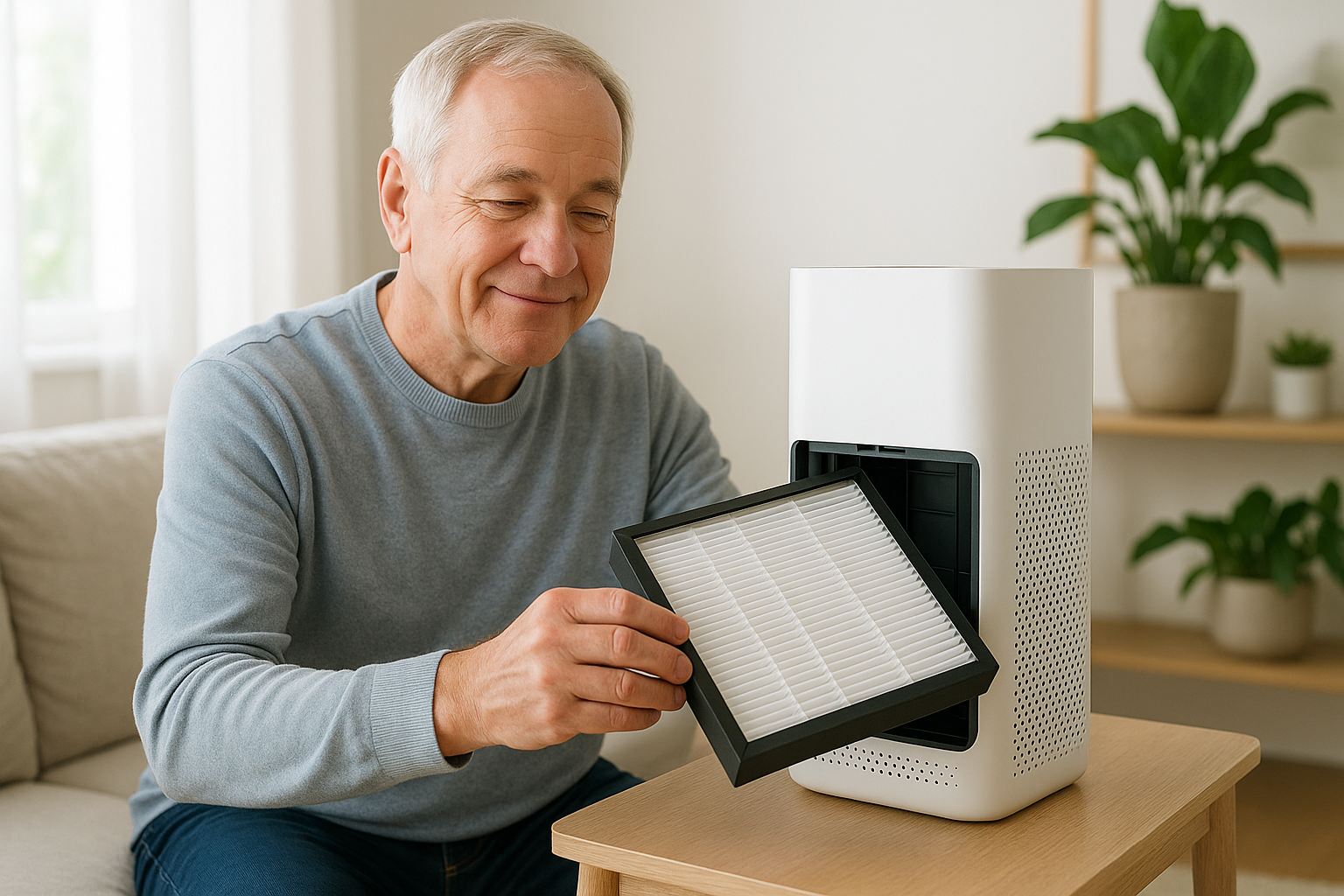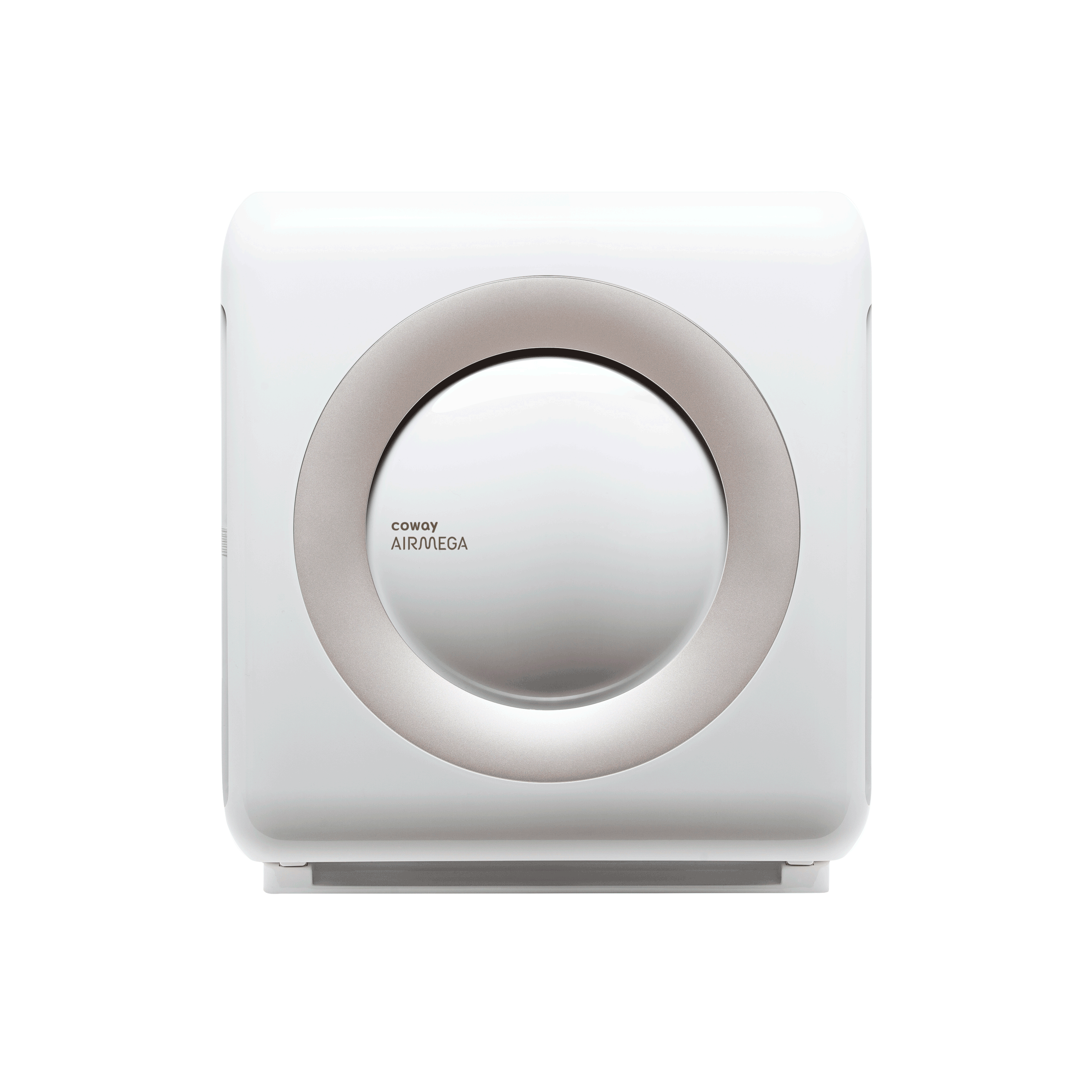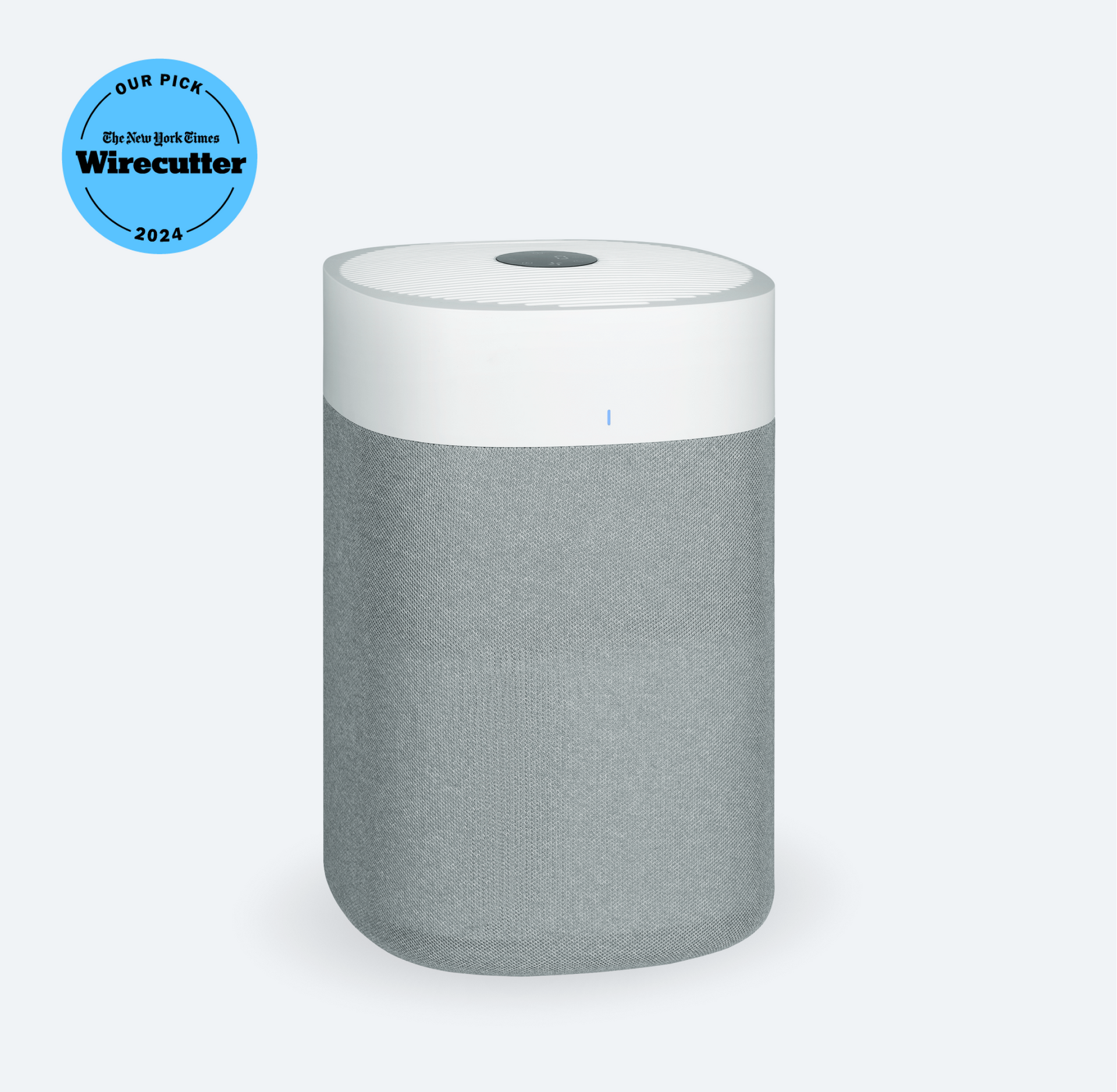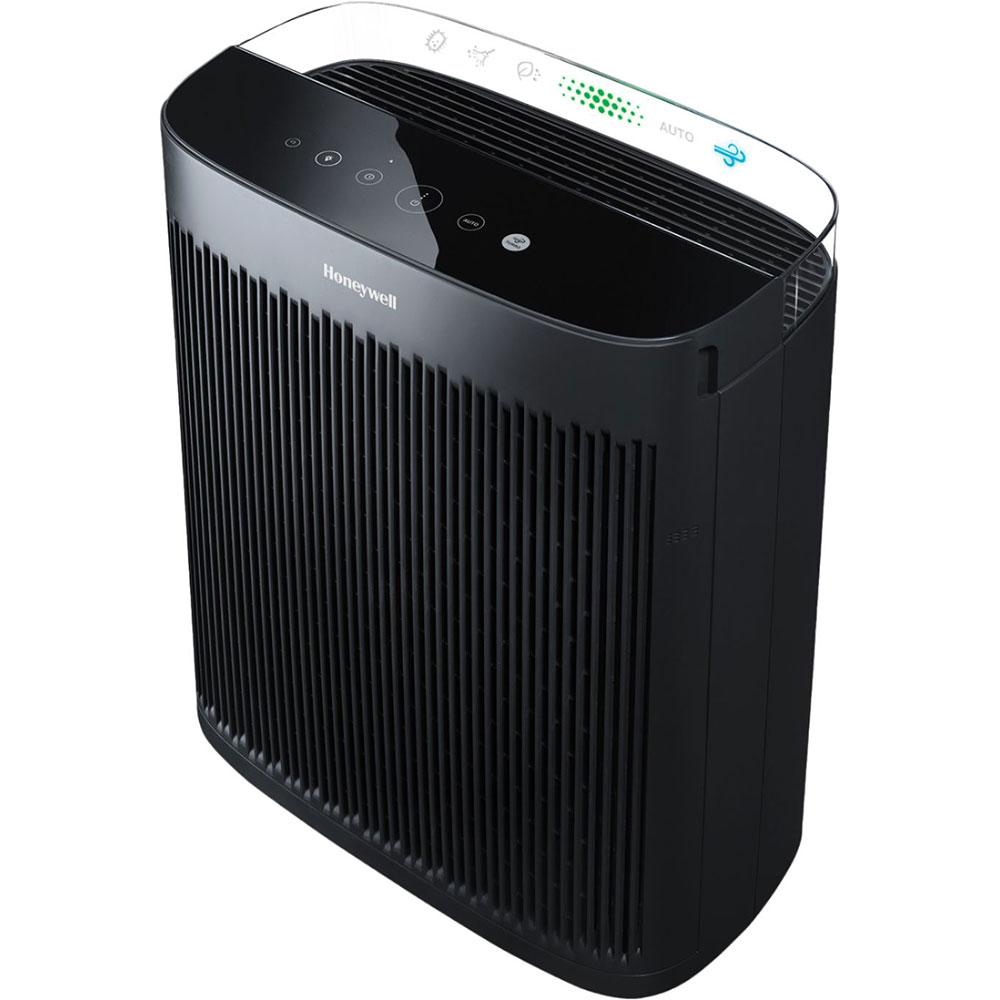Living with COPD means maintaining clean indoor air is non-negotiable. Air purifiers play a key role in reducing harmful pollutants, but their filters must be replaced regularly to remain effective. Here's what you need to know:
- HEPA Filters: Replace every 6–12 months. They trap 99.97% of fine particles like dust, pollen, and smoke.
- Activated Carbon Filters: Replace every 3–6 months. These remove odors, gases, and VOCs.
- Prefilters: Clean or replace every 1–3 months. They catch larger debris and protect main filters.
Factors like indoor pollution, pets, and usage frequency can shorten filter lifespan. Regular maintenance not only ensures cleaner air but also helps manage COPD symptoms by reducing exposure to airborne irritants. Plan filter replacements and budget accordingly to maintain optimal air quality.
How to Change Your HEPA Air Filter
Air Purifier Filter Types and When to Replace Them
Understanding the different filters in your air purifier is essential for keeping the air clean and reducing COPD symptoms. Each filter has a specific role and a unique replacement schedule, ensuring your purifier continues to remove harmful pollutants effectively.
HEPA Filters
HEPA filters are designed to trap 99.97% of particles that are 0.3 microns or larger [5]. These include common COPD triggers like dust mites, pollen, pet dander, and smoke. When selecting replacements, look for filters rated MERV 11–13 [1].
Typically, HEPA filters need replacement every 6–12 months [6][7], but the timeline can vary based on usage and environmental factors. If you live in a highly polluted area, have multiple pets, or run your purifier continuously, you may need to replace the filter closer to the six-month mark. In less polluted environments or with lighter usage, the filter might last up to 12 months. Keep an eye out for signs like reduced airflow, visible dirt on the filter, or an increase in dust at home - these indicate it’s time for a replacement.
Next, let’s explore how activated carbon filters complement HEPA filters.
Activated Carbon Filters
Activated carbon filters specialize in removing odors, gases, and volatile organic compounds (VOCs) that can irritate the respiratory system. These filters work through adsorption, where gas molecules stick to the carbon’s surface. They’re particularly effective at reducing cooking odors, chemical fumes, and vapors from cleaning products [2].
For optimal performance, replace activated carbon filters every 3–6 months [7]. If you frequently cook, use strong cleaning products, or live near heavy traffic, consider replacing the filter closer to every three months. In less demanding conditions, a six-month schedule may suffice.
Let’s now look at how prefilters contribute to the overall efficiency of the system.
Prefilters
Prefilters act as the first barrier, capturing larger particles like hair, lint, and bigger dust particles before they reach the HEPA and carbon filters. By doing so, they help protect the main filters and maintain proper airflow.
Prefilters should be cleaned or replaced every 1–3 months [7], depending on the manufacturer’s recommendations. Many prefilters are washable - simply rinse them with water, let them dry completely, and reinstall. For disposable prefilters, monthly replacements may be necessary to keep your air purifier working efficiently.
| Filter Type | Primary Function | Replacement Frequency | Key Benefits for COPD |
|---|---|---|---|
| HEPA | Captures 99.97% of particles ≥0.3 microns | 6–12 months | Removes dust, pollen, and smoke |
| Activated Carbon | Absorbs odors, gases, and VOCs | 3–6 months | Reduces chemical vapors and odors |
| Prefilter | Catches large particles and debris | 1–3 months (clean/replace) | Protects main filters, maintains airflow |
What Affects How Often You Need to Replace Filters
The frequency at which you need to replace air purifier filters depends heavily on your environment and daily habits. Recognizing these factors can help you establish a maintenance routine that ensures your device continues delivering clean air - essential for managing COPD symptoms.
Indoor Air Quality and Pollution Levels
The air inside your home plays a major role in how hard your air purifier has to work. According to the EPA, Americans spend about 90% of their time indoors, where pollution levels can be up to five times worse than outdoors[8][10].
Several common factors contribute to indoor air pollution. If you have pets, their dander and hair can quickly clog filters. Smoking indoors introduces harmful chemicals and particles into the air, while frequent cooking - especially frying or grilling - produces grease, smoke, and odors that strain filters. Additionally, if you live in areas with heavy traffic or frequent smog, outdoor pollutants can seep inside, further burdening your purifier[9].
To stay ahead, inspect your filters every month. If you notice unpleasant odors, it might be a sign that your activated carbon filter is no longer effective[8]. Beyond air quality, your usage habits also influence how often filters need replacement.
Usage and Household Needs
How you use your air purifier significantly impacts filter longevity. Running the device continuously will cause filters to clog faster compared to occasional use[13].
The size of the room also matters. Larger spaces require more air circulation, which can wear out filters more quickly. For instance, an air purifier in a spacious living room will likely need more frequent filter changes than one in a small bedroom.
High foot traffic in your home is another factor. More movement stirs up dust and particles, leading to faster accumulation on filters[12].
Rather than relying solely on manufacturer recommendations, check your filters monthly to determine if they need replacing[11][13]. Always refer to your air purifier’s manual for specific guidance. Taking these proactive steps can help you maintain cleaner air and better manage COPD symptoms.
sbb-itb-3e96dba
How to Replace Air Purifier Filters
Replacing your air purifier's filters is key to keeping the air clean and ensuring your device works as it should - especially for those managing COPD.
Getting Ready for Replacement
Before you start, always turn off and unplug your air purifier[4].
Check your user manual or look for markings on the existing filter to confirm the correct type. Stick with genuine filters to maintain optimal performance and keep your warranty intact[14]. When removing the old filter, handle it carefully to avoid releasing trapped pollutants into the air. Place the used filter in a sealed bag and dispose of it according to local waste guidelines. Pay attention to any directional arrows on the filter, as they indicate proper airflow orientation.
Once the old filter is removed, you're ready to install the new one.
Installing New Filters
Begin by removing all packaging materials from the new filter.
Follow the manufacturer's instructions to install the filter[4]. Align any directional arrows or markings correctly, as installing the filter backward can reduce its effectiveness. If your purifier has a prefilter, take a moment to clean it while the unit is open. Prefilters can often be vacuumed, wiped with a damp cloth, or rinsed with water, depending on the model[17]. Remember, HEPA and activated carbon filters should never be washed with water[4].
Use a dry cloth to wipe down the interior of the purifier, and clean the air quality monitor with a cotton swab at least once a month[15]. After installation, reset the filter change indicator as outlined in your manual[4].
With the new filter in place, these tips can help you get the most out of it.
Tips to Make Your Filters Last Longer
For optimal airflow, place your air purifier at least 12 inches away from walls and furniture[17]. Avoid positioning it near curtains, large furniture, or anything else that might block the intake or exhaust vents[16].
Clean the prefilter monthly and wipe down the exterior of the unit every two months to prevent dust buildup[17][15]. Using the purifier's continuous auto mode is more efficient and extends filter life compared to frequently turning it on and off[17].
Place the purifier in the rooms where you spend the most time to maximize its benefits while minimizing unnecessary wear on the filter[2]. Regular maintenance not only helps your device perform better but also supports better respiratory health.
Planning Your Filter Replacement Budget
Keeping up with regular filter maintenance is key to improving air quality and managing COPD symptoms. But it’s also something that requires thoughtful budgeting. Over time, filter replacement costs can surpass the initial price of your air purifier, so it’s important to plan ahead.
Filter Cost Comparison
Filters come in different types, each with its own price range and replacement schedule. Here’s a breakdown of the typical costs and benefits of the most common filter types:
- HEPA filters: These can cost anywhere from $20 to over $200, depending on the model of your air purifier[18]. For instance, the Lasko LP300 HEPA Tower Air Purifier has annual replacement costs of about $20.
- Activated carbon filters: These typically cost up to $50 each and need replacing every three months[18].
- Prefilters: The most affordable option, prefilters are priced between $5 and $15. Many of them can be cleaned and reused several times, making them an economical choice for maintenance.
Some air purifier brands also offer long-lasting filters that cost more upfront but need less frequent replacement. For example, the Shark NeverChange Air Purifier Max uses filters priced at $89.95, which can last up to five years, providing better long-term value compared to filters requiring frequent changes.
Here’s a quick comparison of costs and benefits:
| Filter Type | Typical Cost Range | Replacement Frequency | Annual Cost Estimate | COPD Benefits |
|---|---|---|---|---|
| HEPA Filters | $20 - $200 | 6–12 months | $20 - $400 | Removes 99.97% of particles as small as 0.3 microns |
| Activated Carbon | $19.50 - $65 | 3–6 months | $39 - $260 | Eliminates odors and chemical pollutants |
| Prefilters | $5 - $15 | 1–3 months | $20 - $180 | Captures larger particles and extends filter life |
These details can help you estimate your yearly filter replacement costs and plan accordingly.
Yearly Maintenance Costs
To calculate your annual filter budget, multiply the cost of each filter by how often it needs replacing. For example, if your setup includes one HEPA filter ($60), two activated carbon filters ($50 each), and four prefilters ($10 each), your total annual cost would be roughly $200.
However, environmental factors can influence these costs. Homes with pets, high pollution levels, or indoor smoking may require more frequent filter changes. For example, in a home with multiple pets, filters might need replacing every 2–3 months instead of the standard 6-month schedule, potentially doubling your expenses.
Your usage habits also matter. According to air purification expert Mr. Lee:
"To extend the lifespan of your air purifier filters, regularly vacuum dust off the pre-filter, opt for higher CCM-rated filters, and choose models with washable options. Adjust the replacement schedule based on your environment for optimal performance."[19]
To make budgeting easier, consider setting aside $15 to $35 per month for filter replacements. Spreading the cost across the year can help you avoid the financial strain of replacing multiple filters at once.
Conclusion: Regular Maintenance for Better COPD Management
Replacing filters regularly is crucial for keeping air purifiers working effectively. This simple step helps protect your lungs and improves the quality of life for individuals with COPD, especially since clogged filters can significantly reduce the removal of harmful pollutants [4].
HEPA filters are designed to capture 99.97% of airborne particles like dust, mold, and bacteria when they’re in good condition [4]. But their efficiency drops when filters aren’t replaced on time. Considering that indoor air pollutant levels can be 2–5 times higher than outdoor levels [4], staying on top of filter replacements is essential for managing COPD symptoms.
Using well-maintained air purifiers consistently can lead to fewer respiratory symptoms, reduced reliance on rescue medications, and a lower risk of exacerbations [20]. Research even shows that COPD patients using air purifiers with HEPA and carbon filters experienced a 25% improvement in heart rate variability [3], hinting at potential cardiovascular benefits as well.
Dr. Nadia N. Hansel, MD, MPH, emphasizes the importance of indoor air quality for COPD patients:
"Although outdoor air pollution has known adverse respiratory effects, the indoor environment is of particular concern, as most individuals with COPD spend the majority of their time indoors and indoor air particulate matter concentrations in homes of former smokers with COPD have been associated with worse respiratory symptoms, worse quality of life and increased respiratory exacerbations." [21]
This highlights the importance of routine maintenance for air purifiers.
COPD Essentials offers a range of air purifiers, replacement filters, and monitoring tools to help you maintain cleaner indoor air. Following a strict filter replacement schedule is a simple yet effective way to strengthen your COPD management plan.
FAQs
If you start experiencing worsened allergy or asthma symptoms, notice weaker airflow, or detect musty odors coming from your air purifier, it might be time to replace the filter - even if it’s earlier than the recommended schedule. Other telltale signs include visible dust or dirt buildup on the filter or an indicator light on the purifier signaling a replacement is needed.
Certain factors, like heavy smoke, pet hair and dander, or high pollen levels, can cause filters to wear out faster. To keep your purifier running efficiently, make it a habit to check the filter regularly and keep an eye on your home's air quality. This way, you’ll ensure cleaner air and better performance.
Replacing your air purifier filters on time is a crucial step in keeping your indoor air clean, especially for individuals living with COPD. Clean filters work to trap airborne irritants like dust, pollen, pet dander, and smoke - common triggers for COPD symptoms. By cutting down on these pollutants, you may notice fewer flare-ups, easier breathing, and better overall lung function.
Keeping up with filter changes also helps your air purifier run smoothly, ensuring it consistently delivers high-quality air. This small but important task can have a big impact on daily comfort and respiratory health for those managing COPD.
To keep filter replacement costs under control, think about using washable filters - these can be cleaned and reused, cutting down on the need for frequent replacements. Buying filters in bulk packs is another smart way to lower the cost per filter. Choosing air purifiers with durable, long-lasting filters can also reduce how often you need replacements. Additionally, simple upkeep, like cleaning pre-filters regularly and placing your purifier in a less dusty area, can help extend the life of your filters and save you money in the long run.







